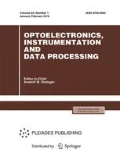Abstract
We show that for the classification of fragments of a hyperspectral image, it is very effective to first transform its spectral features into principal components and then to recognize it using a convolutional neural network trained on a sample composed of fragments of this image. High percentage of correct classification was obtained when working with a large-format hyperspectral image while some of the classes of the hyperspectral image are very close to each other and, accordingly, are difficult to distinguish by hyperspectra. We investigate the dependence of the correct classification on the change in the size of the fragments from which the training and validation samples are composed and on the parameters of the convolutional neural network.
Similar content being viewed by others
REFERENCES
M. Borhani and H. Ghassemian, ‘‘Hyperspectral image classification based on non-uniform spatialspectral kernels,’’ in Proc. of the Iranian Conf. on Intelligent Systems, Bam, Iran, 2014 https://doi.org/10.1109/IranianCIS.2014.6802579.
S. M. Borzov and O. I. Potaturkin, ‘‘Efficiency of the spectral-spatial classification of hyperspectral imaging data,’’ Optoelectron., Instrum. Data Process. 53, 26–34 (2017). https://doi.org/10.3103/S8756699017010058
S. M. Borzov and O. I. Potaturkin, ‘‘Classification of hyperspectral images with different methods of training set formation,’’ Optoelectron., Instrum. Data Process. 54, 76–82 (2018). https://doi.org/10.3103/S8756699018010120
S. M. Borzov and O. I. Potaturkin, ‘‘Spectral-spatial methods for hyperspectral image classification. Review,’’ Optoelectron., Instrum. Data Process. 54, 582–599 (2018). https://doi.org/10.3103/S8756699018060079
B. Fang, Y. Li, H. Zhang, and J. Ch.-W. Chan, ‘‘Hyperspectral images classification based on dense convolutional networks with spectral-wise attention mechanism,’’ Remote Sens. 11, 159 (2019). https://doi.org/10.3390/rs11020159
N. Audebert, B. Saux, and S. Lefèvre, ‘‘Deep learning for classification of hyperspectral data: A comparative review,’’ IEEE Geosci. Remote Sens. Mag. 7 (2), 159–173 (2019). https://doi.org/10.1109/MGRS.2019.2912563
Y. Li, H. Zhang, and Q. Shen, ‘‘Spectral–spatial classification of hyperspectral imagery with 3D convolutional neural network,’’ Remote Sens. 9, 67 (2017). https://doi.org/10.3390/rs9010067
Cross-validation. ITMO University. http://neerc.ifmo.ru/wiki/index.php?title=Cross-validation Cited October 12, 2020.
E. S. Nezhevenko, ‘‘Neural network classification of difficult-to-distinguish types of vegetation on the basis of hyperspectral features,’’ Optoelectron., Instrum. Data Process. 55, 263–270 (2019). https://doi.org/10.3103/S8756699019030087
Overtraining. http://www.machinelearning.ru/wiki/index.php?title=Retraining. Cited October 12, 2020.
Funding
The research was supported by Ministry of Science and Higher Education of the Russian Federation (project no. AAAA-A17-117052410034-6).
Author information
Authors and Affiliations
Corresponding author
Additional information
Translated by L. Trubitsyna
About this article
Cite this article
Kozik, V.I., Nezhevenko, E.S. Classification of Hyperspectral Images Using Conventional Neural Networks. Optoelectron.Instrument.Proc. 57, 123–131 (2021). https://doi.org/10.3103/S8756699021020102
Received:
Revised:
Accepted:
Published:
Issue Date:
DOI: https://doi.org/10.3103/S8756699021020102



